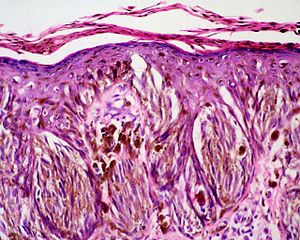Skin nevi
Pigmented nevi are benign skin formations of various sizes created by the local accumulation of melanocytes , which are manifested by a deviation from the normal color of the skin.
Melanocytes are normally arranged individually and far from each other in the skin. Differences in skin pigmentation are primarily due to the activity of melanocytes, not their distribution. In pigmented nevus, a cluster of multiplied melanocytes occurs in a so-called nest.
Clinically, pigmented nevi appear as light brown to brown-black spots or nodules.
Division[edit | edit source]
Congenital pigment nevi[edit | edit source]
These developmental anomalies of the skin are already established during fetal development , i.e. before birth = so-called birthmarks. Congenital pigmented nevi probably arise as a result of impaired migration of melanocyte precursors in the neural crest. These nevi are essentially hamartomas. They occur in up to 2% of newborns, in exceptional cases also in the form of so-called huge congenital melanocytic nevi. They are brown or black in color, may be flat or raised, and terminal hairs are often present. They are potentially malignant - the risk of malignancy increases with the size and number of nevi. Dermatological monitoring is appropriate for pigmented nevi larger than 0.5 cm. As the child grows, nevi can change their appearance - if the color or shape changes, an examination to rule out melanoma is appropriate. Prophylactic removal of the lesion does not guarantee protection against the development of melanoma, therefore dermatological monitoring is also appropriate after removal of a congenital melanocytic nevus. [1][2]
Acquired pigment nevi[edit | edit source]
While congenital nevi are usually single, acquired nevi are usually multiple, from a few dozen to hundreds of formations. Acquired nevi only appear later in life, most often in the period from early childhood to puberty, or up to 20 years of age.
Congenital nevi range in size from 1-2 cm to large multicentimeter areas. The size of acquired nevi usually does not reach 2 cm.
Common pigment nevi[edit | edit source]
These are the most common pigmented skin formations. The color is brown, in various shades. An important sign is homogeneous, homogeneous coloring. The demarcation is sharp, the edges are regular. The nevus can be both at the level of the surrounding skin and elevated, or up to a warty appearance.
For ordinary nevi, it is recommended to remove them in places where they are mechanically irritated - bra straps, flats, brushes, shoes...
Atypical pigment nevi (dysplastic nevi)[edit | edit source]
These formations are irregularly colored, the edges are irregular, occasionally these nevi can itch. The risk of malignant transformation is higher and therefore they should be excised. A special type is the so-called halo nevus – it is a pigmented formation surrounded by a depigmented rim. In adulthood, this central formation should be removed, because it cannot be ruled out that the loss of natural pigmentation of the surrounding skin is already a symptom of an immune reaction to serious pathological changes in the nevus.
Previously, there was a very widespread opinion that pigmented manifestations on the skin must not be surgically removed. The reason was the misconception that birthmarks should be left alone so that they do not cause a serious illness. This is a prejudice that arose in the past, probably on the basis of poor treatment results after excision of melanoma. Since patients were not given a full diagnosis at the time, it was often assumed that the patient died precisely because he had the birthmark removed. It is surprising how this baseless fallacy still persists.
Links[edit | edit source]
[edit | edit source]
Source[edit | edit source]
- ANEČEK, Vladimír: Cutaneous nevus.
Reference[edit | edit source]
- ↑ MCLAUGHLIN, Mr, et al. Newborn Skin: Part II. Birthmarks [online]. ©2008. [cit. 2012-09-04]. <https://www.aafp.org/afp/2008/0101/p56.html>.
- ↑ SALAVEC, M – ČELAKOVSKÁ, J – ŠIMKOVÁ, M, et al. DYSPLASTIC NEVUS, DYSPLASTIC NEVUS SYNDROME AND OTHER MELANOCYTIC PIGMENT NEVUS. : Dermatology for Practice [online]. [cit. 2008]. <http://www.dermatologiepropraxi.cz/pdfs/der/2008/03/06.pdf>.





